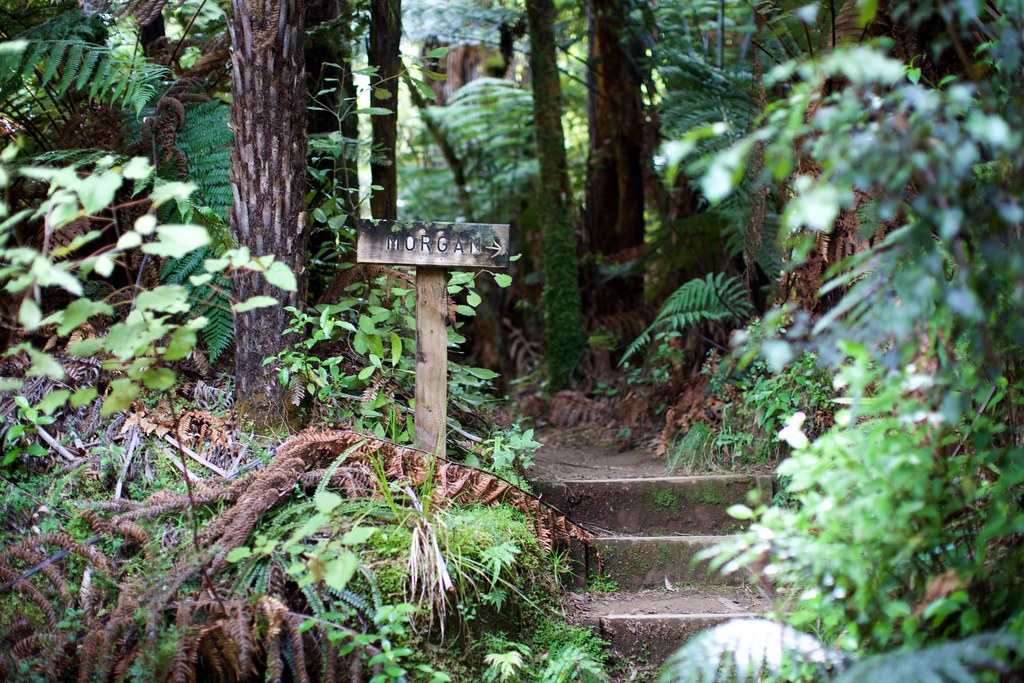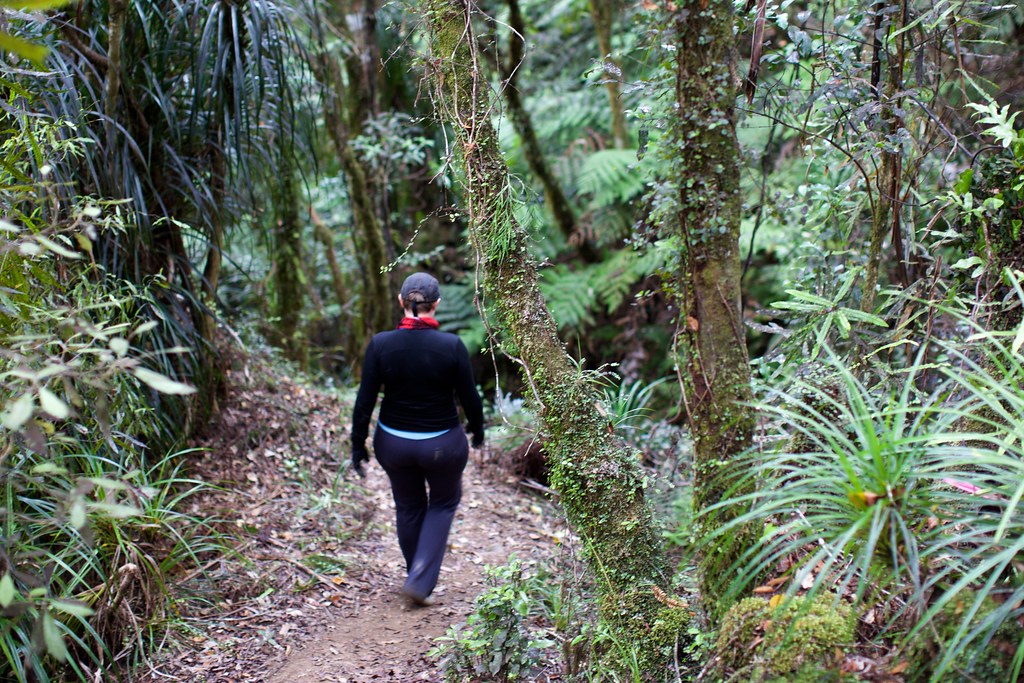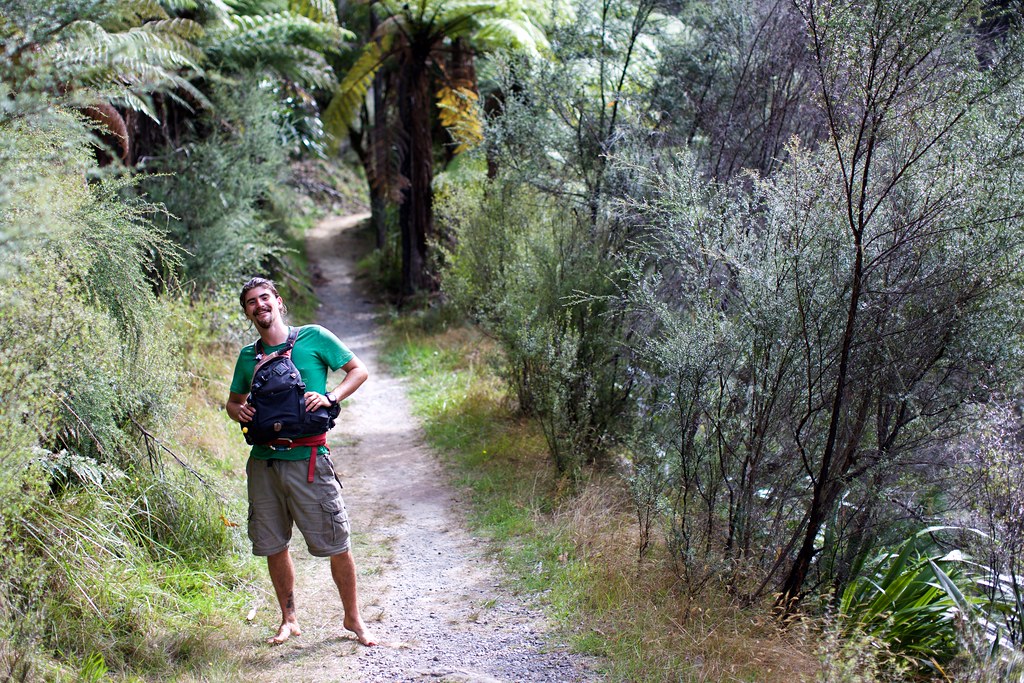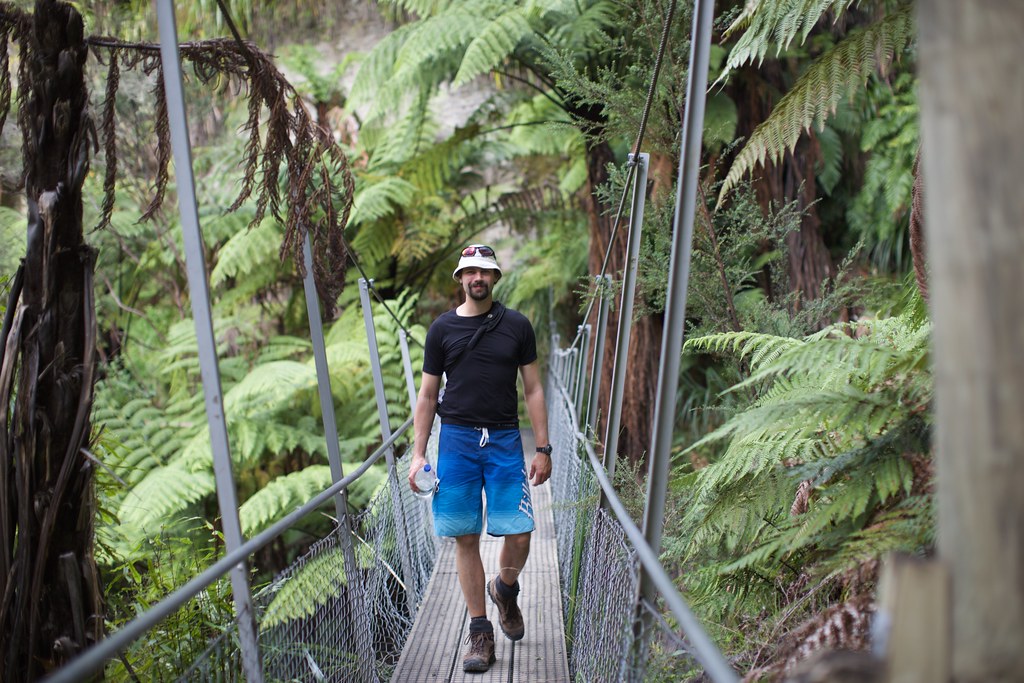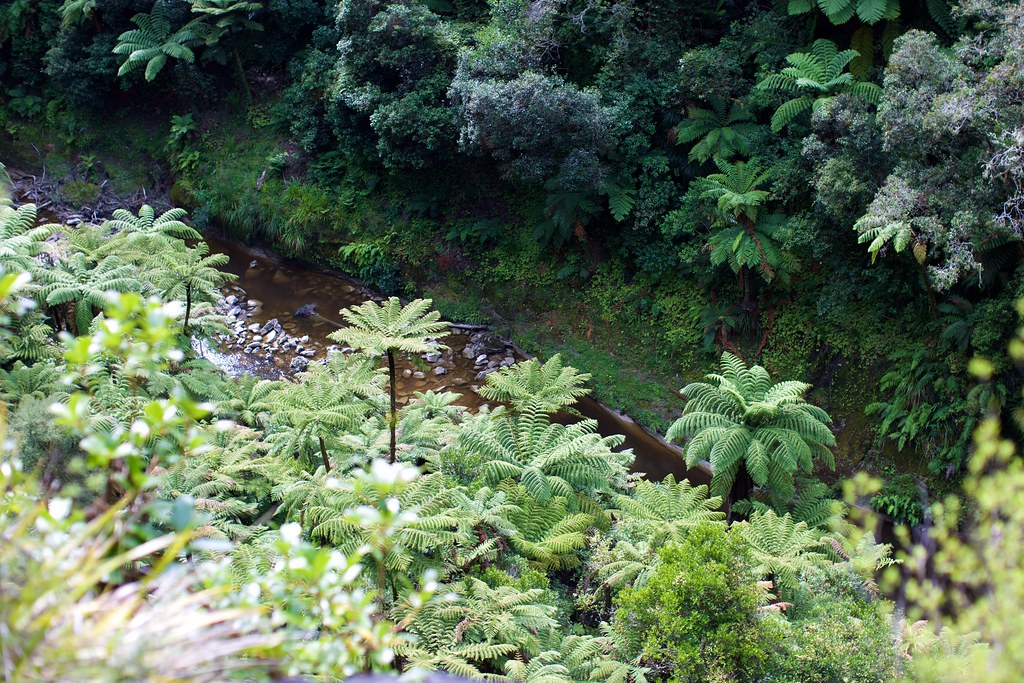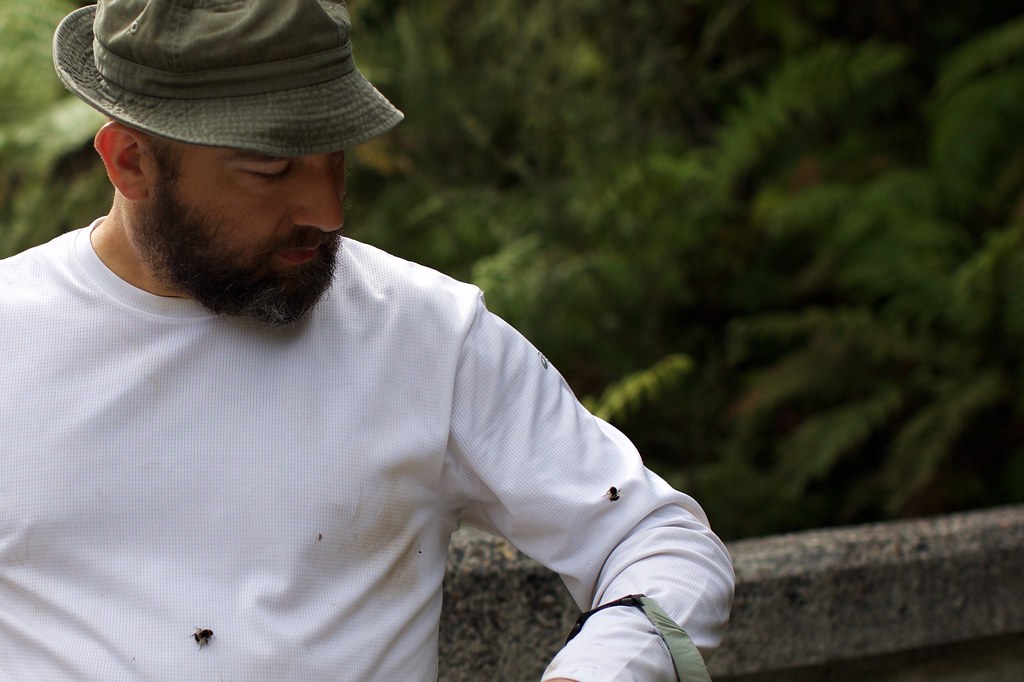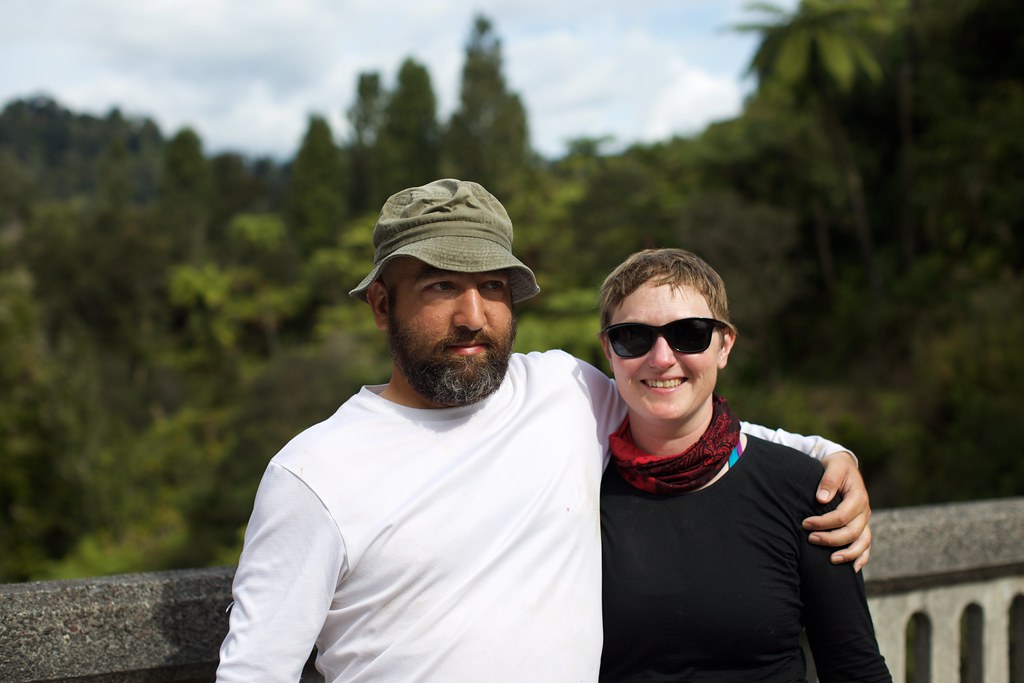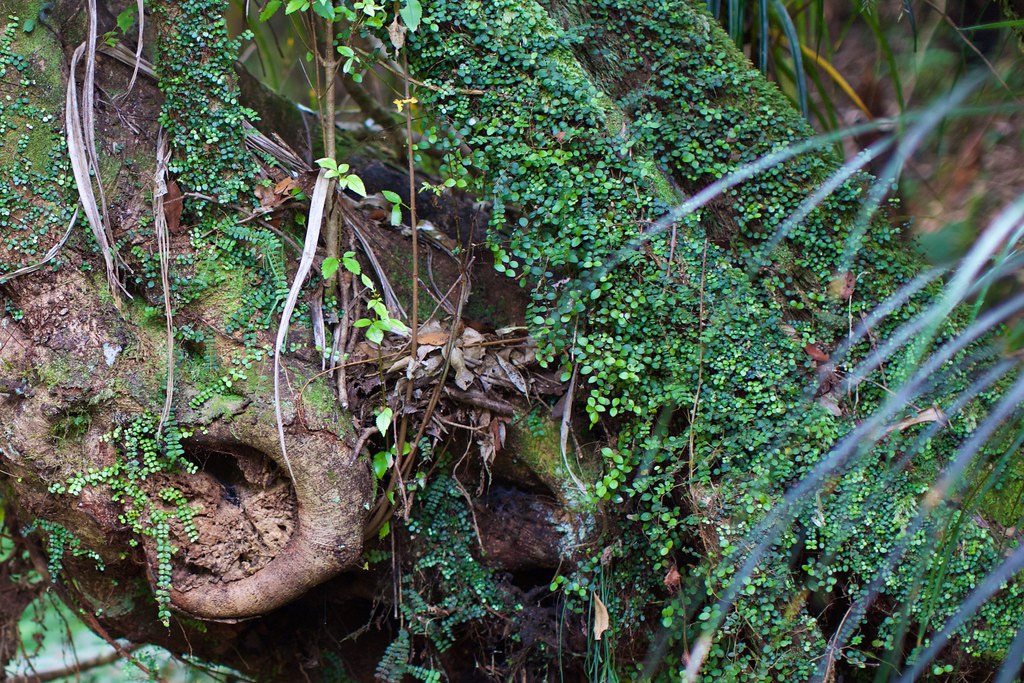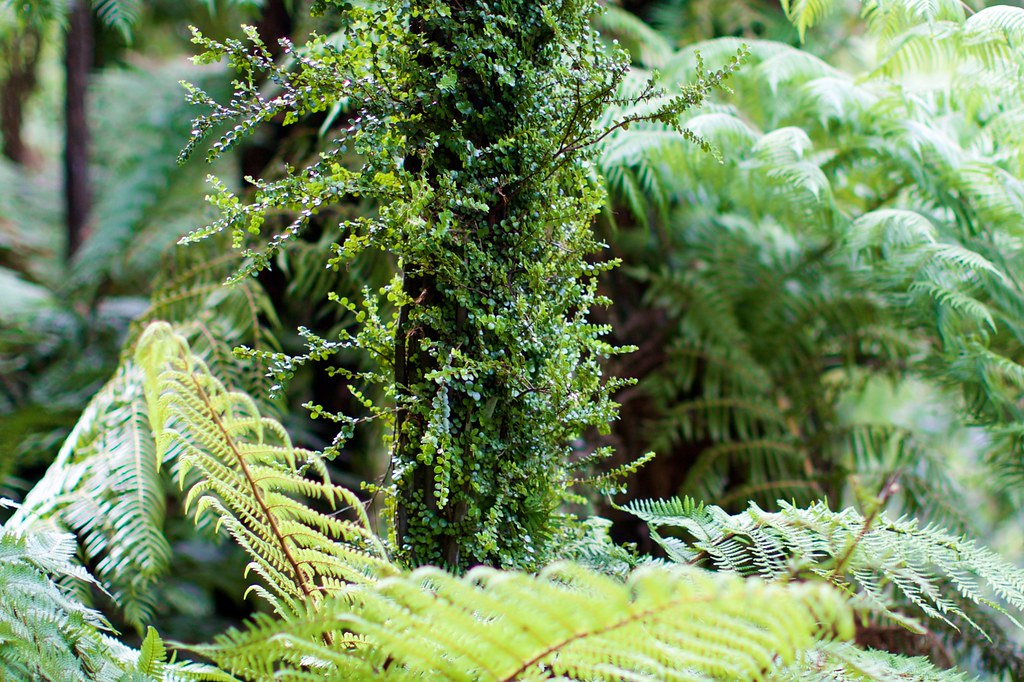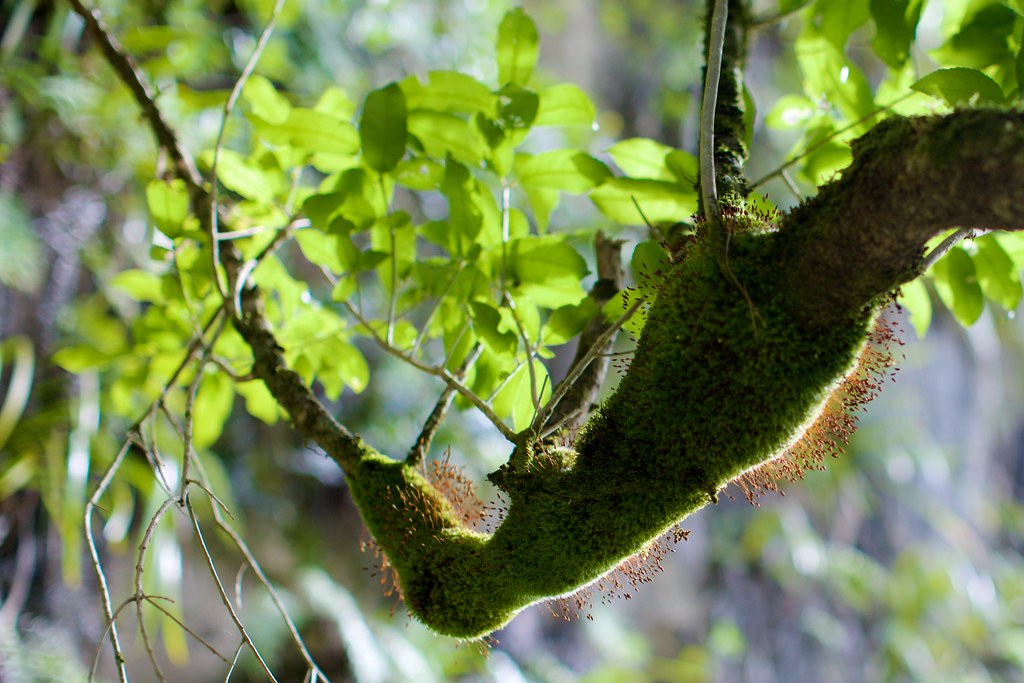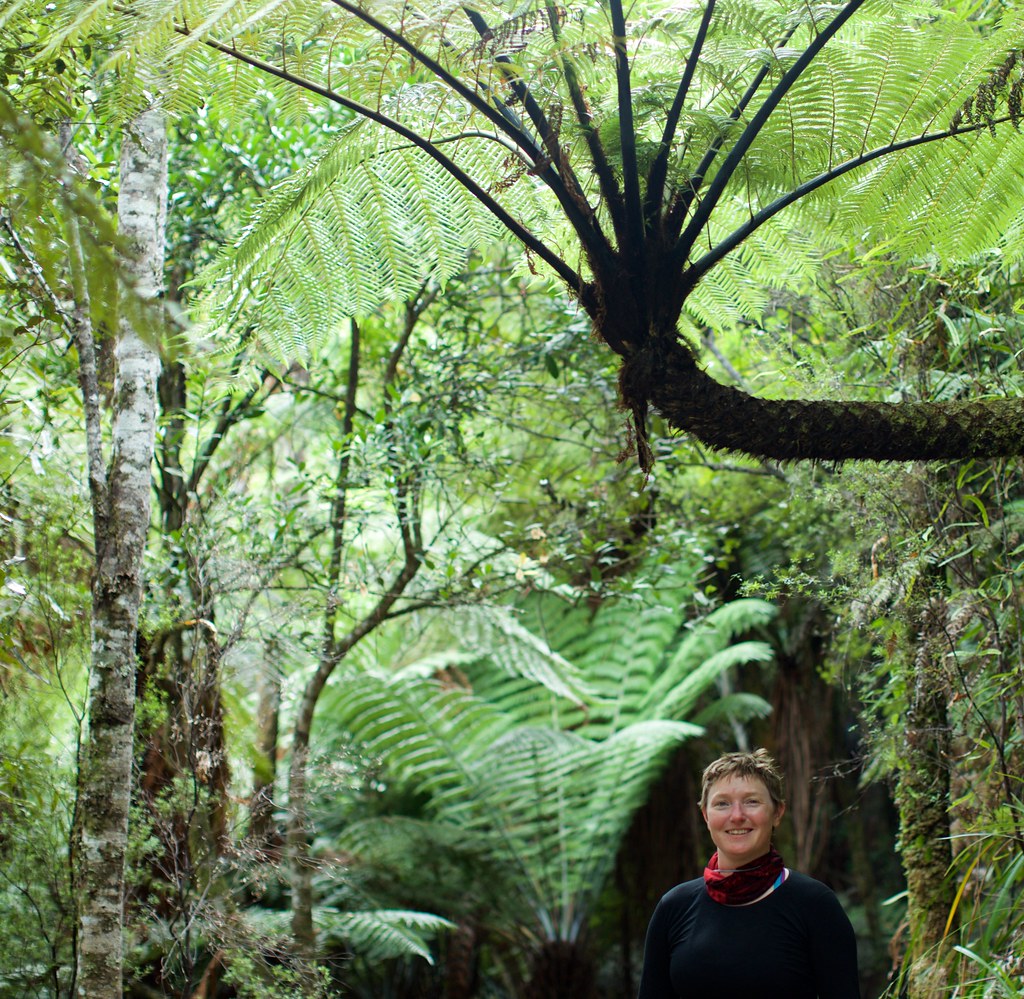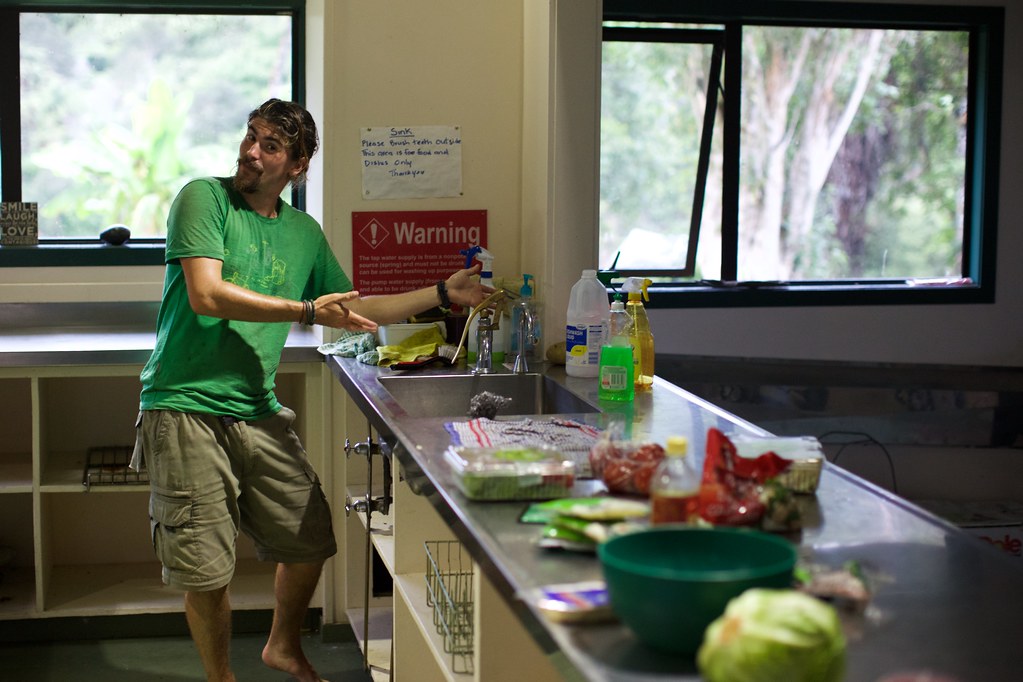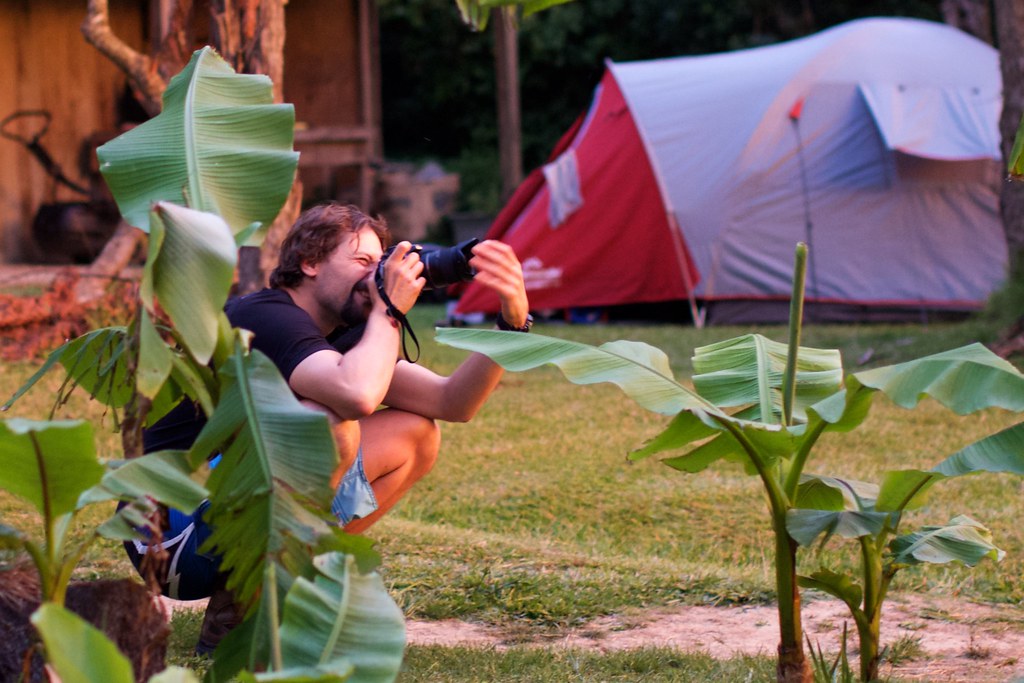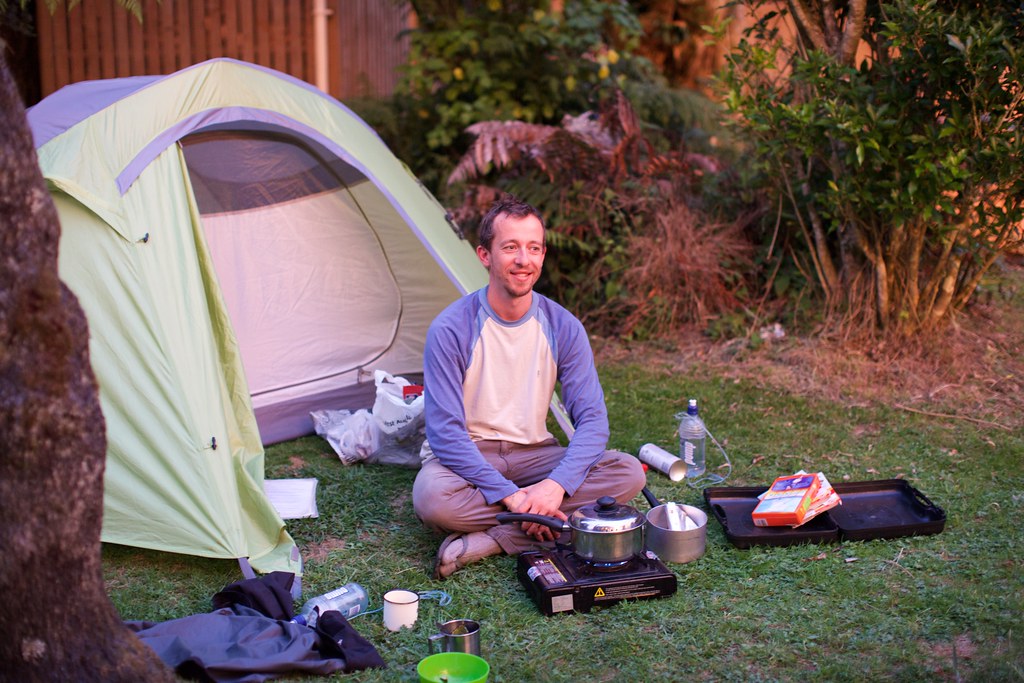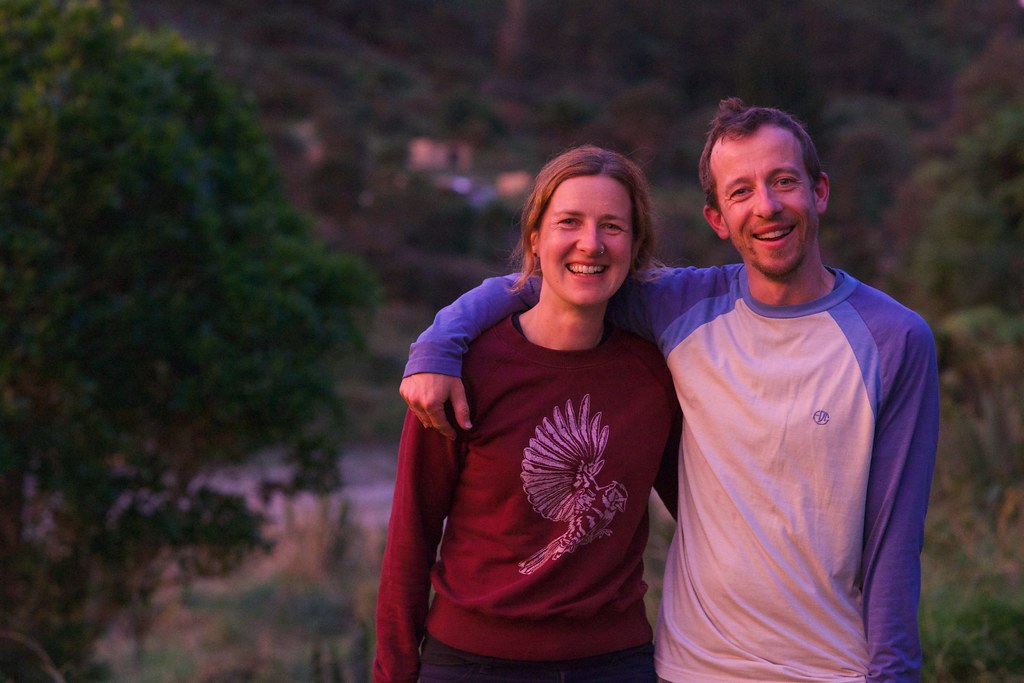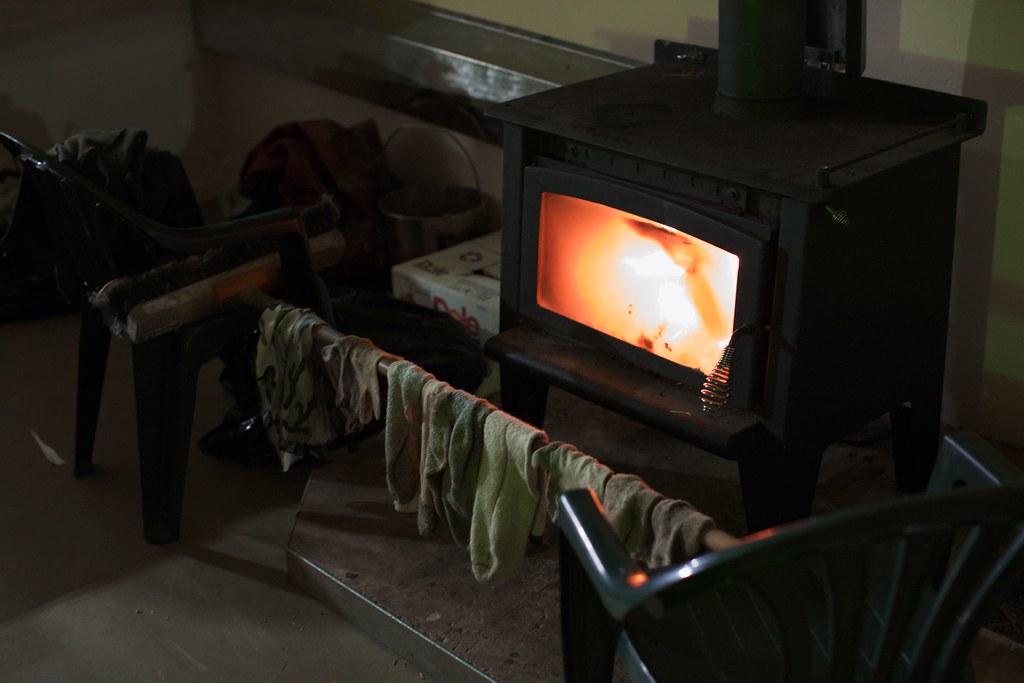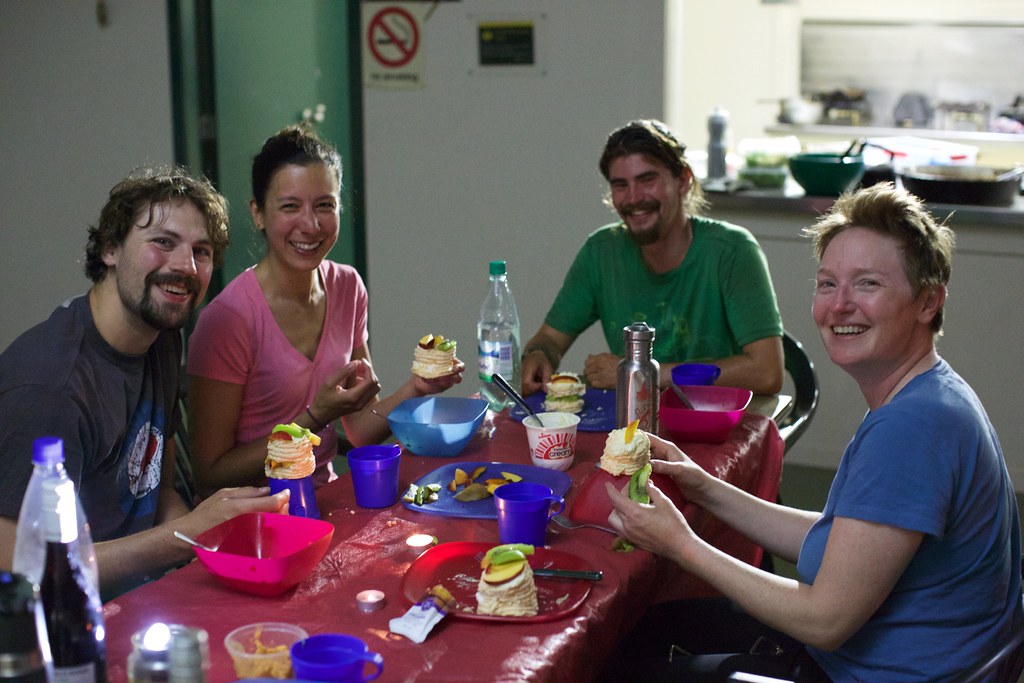NZ Day 21: How Far Canoe Go?
We got up early – no point in trying to sleep longer – and helped Francis get the gear packed and loaded. Then we lingered over breakfast, so our group was among the last to leave. Kerry and I were moving slowly, fighting sleep deprivation.
I couldn’t help wandering around with the camera a bit before we took to the river. Every square foot of land was a cauldron, a wrestling ring, a fireworks show of plant life. Trees and moss and parasitic vines, roots and shoots, fighting tooth and nail. I imagined that if I could see this terrain in fast-forward, with each hour compressed into a second, it would be literally writhing – and if I stood still, watching it that way, I would soon be covered in branches and sucked into the ground.
Shoooop! I think it would make a sound like crinkling paper, and in the last moments, it would be quite painful. Hungry plants…
Some of these plants – like the ones pictured above – grow up and through the trees, eventually climbing over and smothering them.
Others – like the ones pictured below – start as drifting seeds, landing on the tops of trees and taking root directly in the bark, going through an entire life cycle without actually reaching the ground.
That’s the sort of strategy you can evolve when you’re a plant in a forest that’s been extremely dense for eons, with no grazing animals to thin it out and shift the advantage towards grass.
And then there’s the lichen:
Lichen is a composite organism, made from algae or cyanobacteria – or both – living among filaments of a fungus in a symbiotic relationship. Believe it or not, lichen is not actually parasitic, like the plants I described earlier. Lichens don’t put roots down into the trees they perch on, they just anchor to the surface, using them to gain altitude and better access to sunlight for photosynthesis, as well as better access to minerals filtering down in mist or rainwater, from decay happening downwind or farther up in the tree.
The most fascinating thing about lichens, from my point of view, is that they behave like a single organism but they do not actually have any traceable genetic lineage, because the bacteria and fungus that compose them can intermix with other bacteria and fungus on their own terms. So, every lichen everywhere is a hybrid.
Anyway, enough poking around. Time to get back on the river! Here’s a little video of Francis, Katerina, and Sebastian, rowing along.

We went through lots of little rapids today. They were fun, but Kerry and I were both very tired and had trouble communicating our intentions with the oars. I was seated in back, so it was my job to steer, but I also needed to tell Kerry which side to row on and how intensely to row, based on a strategy for passing through each of the rapids. Sometimes I couldn’t come up with a strategy in time so I didn’t know what to tell her. Other times she disagreed with my idea and rowed whichever way made sense to her, trying to steer us from the front. We had a few tense silences, until eventually we worked out a pattern: I would warn her far in advance what the plan was, and give her a number between 1 and 5 for how intensely to row.
“Okay, right side for this one. We’re gonna aim straight for the middle of that wave, then pitch out to the left. Gimme a 2 to start with…”
After sailing through a particularly devious sequence of rocks, waves, and upwellings, Francis drifted up to us and said, “hey, good job working that out. That’s one of the biggest rapids on this part of the river, and most people just stop rowing halfway through it because it’s like being on a bucking bronco. You guys kept rowing the whole way through. I’m impressed!”
Kerry and I felt a little better about our skills after that!
At the next rest stop we had more chocolate, cheese, fruit, veggies, and sandwiches. Kerry flopped down onto the shore and barely moved. I wandered up and down our little elbow of land, trying to get some heat into my feet, which had been cold ever since we stepped in the river to launch the canoes in the morning.
We saw a big jet-boat go roaring up the river, stirring up long rows of waves that slapped against the cliffs. I was surprised the Department Of Conservation allowed it, but Francis explained that the boat was essential for rescue operations and moving large amounts of gear.
“Many years ago, there were a lot more boats on this river, including a steam-based paddleboat service that ran for 70 years,” he said. “We’ll be passing one of the old mooring stations tomorrow and I’ll point it out.”
“Why did the service stop?” I asked.
“Well, eventually the railroad extended to the southern coast, and the ferry service got out-competed. So they decommissioned the ferry boat, and it sat parked on the river for years getting older and older until it just sank.”
“And that was it? No more boats?”
“Oh no, plenty of boats still. Just not that big. For a while there were lumber companies moving cargo on the river. Then there were raft races, and jet boat races, but those stopped in the 1980’s. Then about 15 years ago, some people got together with some money and raised the original riverboat up, restored it so it looks great again, and started up a little bit of the original ferry service as a tourist attraction.”
“Wow! Pretty cool!”
“Yeah. And couple years ago, another riverboat service started with a newer, smaller boat, and you can take rides on that too, pretty far up the river. But personally, I think canoeing is a much better way to go. Of course.”
“Of course!”
We loaded into the canoes and paddled for another couple hours, moving through easy rapids, chatting with each other, staring curiously into the shadowy channels that snaked into the cliffs on either side, and having a good time. I promised myself I would come back with a kayak at some point, and explore some of those channels — but there’s so much more to explore I doubt I’ll keep that promise.
Eventually we zig-zagged into a tributary of the river, and tied the canoes up near a trail that was the side-entrance to the “Bridge To Nowhere” hiking area. The ascent was treacherous and muddy, and we had to cling to knotted ropes for some of it. Whoo!
As we walked the main trail, Francis told us about how the earlier settlers managed to drive cattle here, trying to get their ill-fated farming claims established. They played “sideways rugby” on the hills for entertainment, since it was impossible to find flat ground for a field.
Here’s a hyperspeed video of some of the trail we walked:
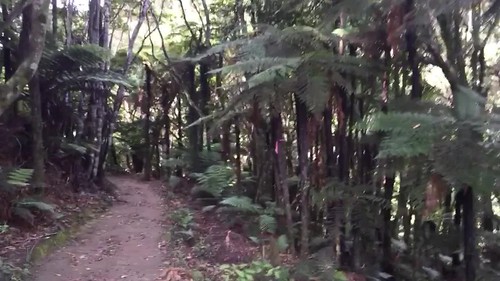
Pretty twisty, huh?
And all this walking, sandwiched in the middle of a full day of rowing, after two days of poor sleep! We’re pretty tough!
Eventually we emerged on the side of a steep ravine, with a tributary of the river at the bottom.
Then we crossed a small bouncy rope-and-chain bridge, and came upon the object of our quest: The “Bridge To Nowhere”.
We hung out there for a while, enjoying the weirdness of a solid, modern-looking bridge in the middle of a dense forest along a dirt hiking trail.
A nearby sign told us some history:
“An opportunity to nowhere!” It looks as ominous as it sounds. We were standing in a huge expanse of near-trackless forest that had completely swallowed all evidence of the attempted farming from decades ago, except for some broken-down farming machinery and the bridge, which was obscured by dirt and vines and missing its railings and most of its top surface when explorers found it years later.
Eventually we turned back towards the boats. First we crossed back over that bouncy rope-and-chain bridge:
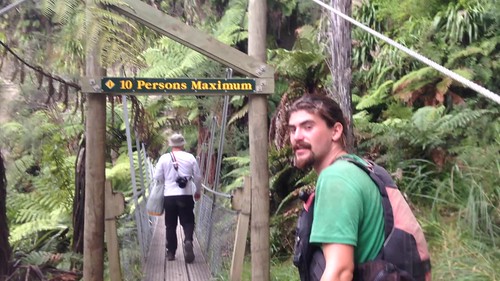
“It’s like a free bouncy house, but over a cliff!” Kerry said. “Or is it a ravine? Or a gorge? Or a canyon?”
That prompted a long discussion while we attempted to define each of the words. Our usual solution – look it up on the internet – didn’t work because we were a long way from any internet service. So we just walked and talked, while the forest buzzed and chirped around us.
I posed Kerry beneath a fancy-looking tree:
We got so engrossed in walking and talking that we missed the turnoff for our canoes, and had to walk back up the trail quite a ways to find it.
Back in the water, we paddled along. My feet were wet from launching the boats – again – and this time I got attacked by a horde of sand flies. Aaagh! I had to pause in my steering to slap angrily at them, but I only squished maybe five out of a hundred of the little bastards. I ended up with specks of my own blood all over my feet.
Francis, meanwhile, had his feet bare the entire time, and the flies didn’t even notice him. Just another example of his Super Outdoorsman Powers.
In a little while we arrived at the second cabin site. We beached the canoes and hauled everything up the hill, and Francis set about making another fine meal in the common area kitchen:
Then Sebastian, Kerry, and I went stalking about with our fancy cameras. Of course!
We said hello to the other tourists, and chatted with a few of them. They ran the spectrum from friendly and energetic to exhausted and surly.
Here are two of the super-friendly ones! Sorry, I can’t remember their names…
The sunset made for some gorgeous backlit shots of the foliage.
This is the view across the river near sunset, at the campsite. If it looks a bit like farmland gone to seed, that’s because it is. The owners have switched to tourism, and opened a lodge on their property with access to the river.
Eventually I walked back inside to check on Francis. He was almost done cooking! Near the kitchen area I discovered a wood-burning stove, and with permission I set about building a fire. Sebastian rigged up a drying pole across the front of the stove using an old broom, and we all hung our wet socks along it.
Aah the comforts of civilization!
Here are the happy campers, enjoying dessert provided by Francis: A merengue with condensed heavy cream, traditionally eaten with kiwi fruit or peaches. Can’t beat that classic combination of sugar and fat! Kerry made me some hot cocoa, too.
We stayed up late talking about travel ideas and making jokes, until someone came in from the tent area and told us we were keeping everyone awake. Sebastian and Katerina decided to sleep outside and Francis offered them his tent, which he wasn’t using since he planned to sleep in the kitchen area. The stove had warmed it up nicely. Kerry and I went back to the bunk room, and crawled into our borrowed sleeping bags.
Unfortunately, shortly after Sebastian and Katerina settled in, their tent filled up with bugs, driving them inside with Francis. Then, as the hours passed, the sink slowly overflowed because someone had left the plug in it. Francis woke up in the morning with his blankets soaking wet — and somehow, he was still cheerful!




